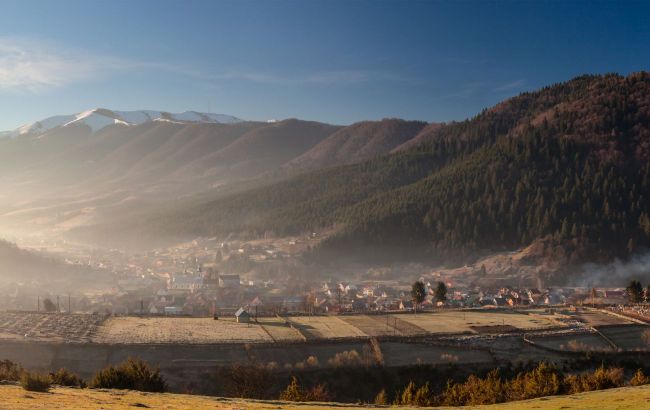Hidden village gems in Ukraine you need to see to believe
 Which 5 Ukrainian villages will impress you more than resorts in Europe (photo: wikimedia.org/Moahim)
Which 5 Ukrainian villages will impress you more than resorts in Europe (photo: wikimedia.org/Moahim)
Cozy, picturesque, and authentic—some Ukrainian villages captivate you with their atmosphere even more than well-known European resorts. Here, you can find true tranquility, be closer to nature, and discover what tourists often overlook. Which five villages in Ukraine will impress you as much as European resorts?
Kolochava, Zakarpattia
This village in the Khust district of Zakarpattia region, located in the heart of the Carpathians, looks like an open-air museum.
There are 10 (!) museums here, including the unique "Old Village," which showcases ancient Hutsul houses, churches, and equipment. The village also features many interesting historic monuments and churches, some of which are nearly 300 years old.
Kolochava is situated in a mountain valley between the highland pastures of Strymba, Darvaika, Barvinok, Krasna, and Ruzha. Several rivers flow through the settlement: Nehrovets, Hersovets, Sukhar, and Kolochavka.
There is a "Bird Park" here, home to many bird species, and a nearby weather station is also in service.
Kolochava has a fascinating history. It was founded in the first half of the 15th century by fugitives fleeing serfdom. Each settler built their own hut with small windows, a clay floor, a thatched or wooden roof, no chimney, and a fire pit in the center.
Kolochava is a place where nature and history intertwine, and the air smells of smoke and spruce. It is perfect for those seeking peace, mountains, and authenticity.


 Village Kolochava in Zakarpattia (photo: Wikipedia)
Village Kolochava in Zakarpattia (photo: Wikipedia)
Sheshory, Ivano-Frankivsk region
A picturesque village in the Kosiv district of Ivano-Frankivsk region, known for its waterfalls, clean river, and pine forests. The legendary ethnic festival "Sheshory" was held here.
In summer, you can swim in mountain streams; in winter, stroll along snowy ridges. A bonus is the local cuisine and the Hutsul charm you won't find in any European supermarket.
The settlement existed as far back as the Stone Age, though the first official records date from 1427. Here you'll find one of the oldest Hutsul churches—the Upper Church—and the most famous Silver Waterfalls in Ukraine.

 Village Sheshory in Ivano-Frankivsk region (photo: Wikipedia)
Village Sheshory in Ivano-Frankivsk region (photo: Wikipedia)
Trypillia, Kyiv region
This village in the Obukhiv district of Kyiv region was founded in the early 11th century and was historically known as Trepol. It offers an unexpected combination of natural beauty and deep history.
This is the birthplace of the famous Trypillian culture. The view of the Dnipro from the local hills rivals that of Tuscany, and the Trypillia Museum and archaeological sites can impress even those who've visited the Louvre. And it's only an hour's drive from Kyiv.
At the village's entrance stands Divych-hora, where an altar to the goddess-maiden of the Zarubyntsi culture (3rd century BCE) was uncovered. In 1093, the Cumans defeated the Rus' army in the Battle of the Stuhna River here.
.jpg)
.jpg) Village Trypillia in Kyiv region (photo: Wikipedia)
Village Trypillia in Kyiv region (photo: Wikipedia)
Pidkamin, Lviv region
The village got its name from the giant boulder that looms over the area. It also features a large monastery that looks like a medieval fortress.
In the village, there is also a well-known geological landmark—the erosional remnant of Sarmatian-age marine reefs, part of the Tovtry or Medobory range.
Pidkamin was first mentioned in archives in 1441 as the "city under the rock." Among the notable landmarks is the Monastery of the Tree of the Holy Cross of the Studite rule.
One of the witnesses of the past is a unique natural monument—a rocky giant located on a high hill on the northeastern outskirts of the village, popularly called "The Rock."
The 16-meter-tall stone outcrop has always drawn attention due to its grandeur. In the eyes of our ancestors, it was spiritual and supernatural.
Pidkamin is is a place of harmony, serenity, spirituality, and unforgettable panoramic views. There are few tourists here, so the atmosphere remains highly authentic.


 Village Pidkamin in Lviv region (photo: Wikipedia)
Village Pidkamin in Lviv region (photo: Wikipedia)
Bakota, Khmelnytskyi region
A submerged village above the Dniester has become a truly legendary place. The landscapes here could easily serve as the backdrop for a film about Greece.
A rock monastery, the silence of the canyon, and the whisper of the water create an effect of being "disconnected from the world."
According to meteorologists, this region has a unique microclimate—the annual average solar radiation per square meter equals that of Yalta, and the cliffs and forests protect the Dniester shoreline from northern winds.
Archaeological excavations show that along the Dniester's shores in this area, there were many pagan sanctuaries, temples, and burial mounds with female graves.
Bakota is first mentioned in the chronicles in 1240. In the 18th century, it was a large town that belonged to the Galicia-Volhynia principality. The first mention of the male cave monastery was recorded in 1362, where it was referred to as "long established."
Its founder was the venerable elder Anthony, that monk who founded the Kyiv Pechersk Lavra. In 1255, when the Mongol-Tatars attacked Bakota, monks hid the townspeople in the labyrinth of monastery caves.
In 1996, the collapse of the upper cliff of White Mountain destroyed most of the caves and the unique tomb with wall paintings and frescoes from the 11th to 13th centuries. Nevertheless, pilgrims and travelers flock to the monastery's remains every year. Bakota is a Ukrainian retreat, needing no words.


 Bakota (photo: Wikipedia)
Bakota (photo: Wikipedia)
Don't rush to buy tickets to Italy or Slovenia. First, try visiting a Ukrainian village. You'll be surprised at how much beauty is nearby—without visas, crowds, or tourist clichés.
You may be interested in:
- 7 most interesting gastronomic routes for tourists in Ukraine
- Why you should see the Akkerman Fortress at least once in your life
- Where the most beautiful canyons in Ukraine are located
Sources: tripmydream.ua, Ukraine Travel, Zruchno.Travel, Ridna Ukraina, Visit Ukraine.

